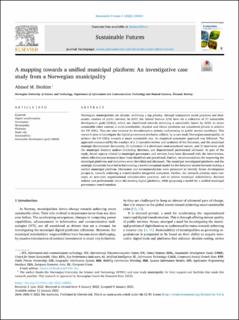| dc.description.abstract | Norwegian municipalities set citizens’ wellbeing a top priority, through transparent social practices and democratic conduct of public services. In 2015, the United Nations (UN) have set a collection of 17 sustainable development goals (SDGs), which are interlinked towards achieving a sustainable future by 2030. In smart sustainable cities context, a multi-stakeholder, physical and virtual platforms are considered pivotal to achieve the UN SDGs. They are core initiator for transformative actions, endeavoring on public service excellence. This research aims to investigate the digital governance platforms utilized, by a case study Norwegian municipality, to achieve the UN SDGs; towards a smart sustainable city. An empirical systematic approach was followed. The approach commenced by the conduct of a 1) narrative review and synthesis of the literature, and the municipal strategic development documents, 2) collection of a developed semi-structured survey, and 3) interviews with the municipal decision makers (including directors, and departmental professional advisors). As part of the study, broad aspects related to municipal governance and services have been discussed with the interviewees, where effectiveness measures have been identified and prioritized. Further, recommendations for improving the municipal platforms and initiatives were identified and discussed. The municipal investigated platforms and the strategic documents have led to formulating a novel conceptual model for the behavior needed towards making a unified municipal platform. Discussion and recommendations were presented to identify future development prospects, towards achieving a transformative integrated ecosystem. Further, the research presents main concepts, to articulate organizational administrative practices, and to inform municipal stakeholders, decision makers and professionals about the existing digital platforms, while proposing a model for a unified municipal governance transformation. | en_US |

